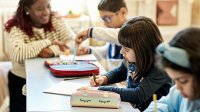A Sustainable Plan for Meeting Learners Where They Are
If differentiated instruction is too personalized and complicated, teachers won’t be able to keep it going. Here’s how to do it for the long haul.
Your content has been saved!
Go to My Saved Content.Differentiated instruction in schools can be as straightforward or as complex as we make it. We do have a tendency, however, to overcomplicate it. We convince ourselves that the more individualized instruction is, the more personalized it will be. This results in unsustainable practices for personalizing learning, such as planning concurrent lessons for leveled groups or even playlists that are hard to maintain over the course of the school year.
My experience with these unsustainable practices while working for a personalized learning company in Silicon Valley led me back to the tried-and-true practices for meeting learners where they are. Not only are these best practices, but they are sustainable. Teachers can use these without spending nights and weekends planning and assessing learning.
Design With the End in Mind
We can’t meet learners where they are if we don’t have a solid learning plan. Grant Wiggins and Jay McTighe’s backward design framework helps us create a flexible and sustainable learning plan in three stages. When we use design units of instruction backward, with the end result in mind, we find clarity in what we’re teaching, why we’re teaching it, and how we’ll universally design instruction along the way for all learners.
- Stage I: Identify the desired results of a unit of instruction. This offers an opportunity to deconstruct standards and anticipate both prerequisite skills and varied levels of proficiency.
- Stage II: Identify success criteria and tools for generating and collecting evidence of student learning.
- Stage III: Create a learning plan that accounts for the aforementioned varied levels of proficiency, meanwhile providing all learners access to grade-level standards.
Within this learning plan, sequence open-ended tasks, and create a menu of choices that accounts for varied needs.
Use Open-Ended Tasks
In order to differentiate, teachers often mistakenly believe they need to create leveled groups and plan different activities for each group. This is both unsustainable and inequitable, leading to tracked groups of students: Students with lower test scores will have access to lower levels of activities than their counterparts with higher test scores, exacerbating opportunity gaps.
The alternative is to use open-ended tasks, designed with varied access points for different learning profiles. In order to differentiate, anticipate learners’ potential responses to the task. For instance, with students studying multi-digit subtraction in second grade, recognize that some learners may need manipulatives like base-10 blocks or number discs, while others will require number lines or grid paper. Consider ways to enrich the task, too, supplying learners with larger numbers or opportunities to analyze algorithms to determine which is the most efficient.
In literacy, this could entail having learners write alternative endings to stories or journaling openly about their interpretations related to character development or theme within a story, which shifts learners away from “correct” answers and instead opens learning up to a myriad of interpretations.
This also makes differentiation sustainable: Teachers plan one open-ended activity, while learners leverage their agency to choose paths that work for them.
Create Menus of Choices
When learners feel empowered to work at different rates, it means we’ve created an environment where they feel comfortable being themselves. This raises challenges too. Some learners will finish open-ended tasks earlier than others.
To address this, create menus of after-task choices. These should be aligned with the learning goals from your unit plan and account for anticipated levels of proficiency. For instance, in the aforementioned second-grade unit on addition and subtraction, teachers might provide learners with two to three different math games to play.
Choice in literacy can be even simpler. When we build independent reading routines and coach learners on book selection, students can engage in a ritual of choosing and completing books, using their extra time to read independently—one of the strongest influences of sustained reading achievement. In writing, learners can choose between peer feedback, revising, editing, or starting a brand-new piece within the genre unit of study.
Encourage Self-Reflection
In order for differentiated instruction to be sustainable, we must make learners’ roles in the classroom clear so that they know what they need to do. This starts with giving them choice in activities they feel will meet their needs, meanwhile regularly encouraging self-reflection. After all, it’s important to coach learners in making productive choices that are meeting their needs.
Try this generic reflection structure as a place to start:
- What worked today?
- What didn’t work?
- What will you do differently tomorrow?
This offers learners opportunities to reflect on strategies, methods, or responses from the open-ended task, while also reflecting on their choices from the learning menu. Some students might decide that they need a more challenging math game or that they want to start a new writing piece tomorrow.
What Really Matters
The goal of differentiated instruction is simple: Meet learners where they are. But we know that teacher burnout is a real issue in schools, and therefore our approach to differentiation must be sustainable. What matters most is that these choices keep learners engaged in meaningful activities, sustaining their engagement without the teacher having to micromanage them.
Changing the approach to differentiated instruction also must be sustainable. If you’re just getting started, don’t make all of these changes at once. Start with incremental shifts in practice like encouraging self-reflection, and when you’re ready, begin exploring open-ended tasks or learning menus. Setting incremental but meaningful goals will be critical to sustained success with meeting learners where they are.
